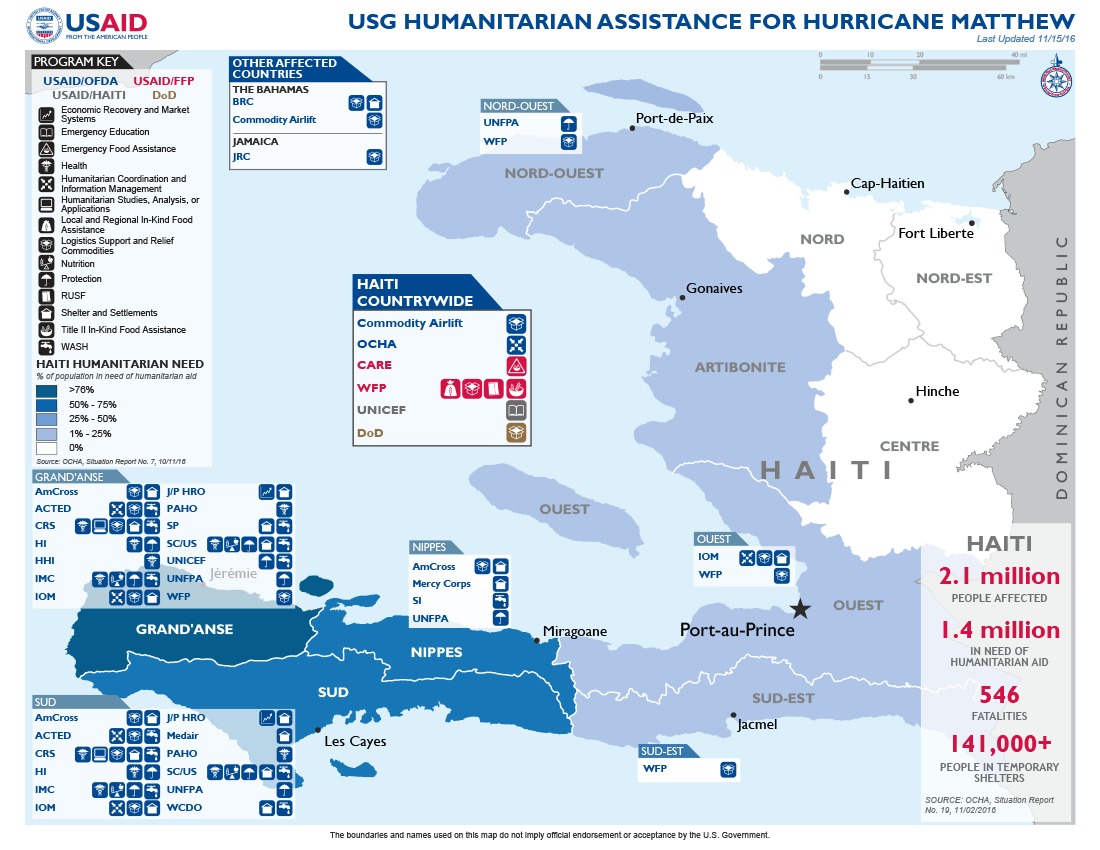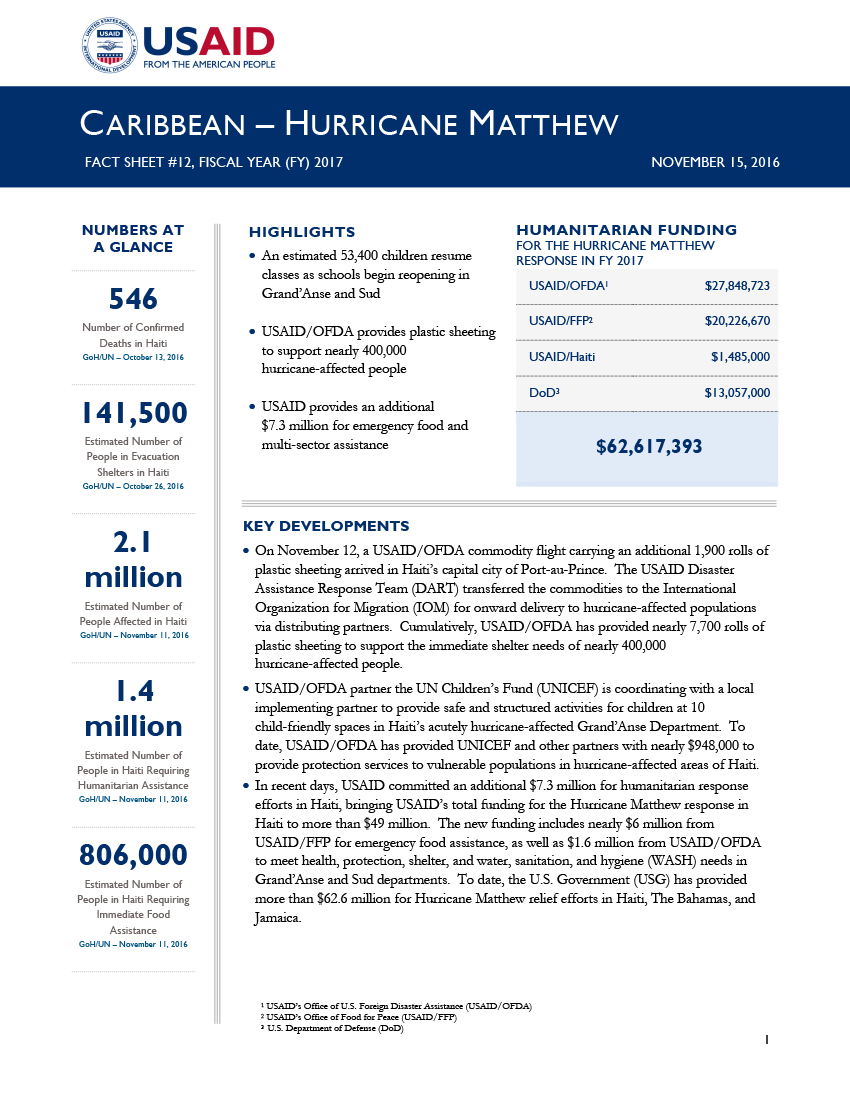November 15, 2016
Highlights
An estimated 53,400 children resume classes as schools begin reopening in Grand’Anse and Sud.
USAID/OFDA provides plastic sheeting to support nearly 400,000 hurricane-affected people.
USAID provides an additional $7.3 million for emergency food and multi-sector assistance.
Key Developments
Numbers At A Glance
546
141,500
2.1 million
1.4 million
806,000
Humanitarian Funding
For the Hurricane Matthew Response
in FY 2017
| USAID/OFDA | $27,848,723 |
| USAID/FFP | $20,226,670 |
| USAID/Haiti | $1,485,000 |
| DoD | $13,057,000 |
| TOTAL | $62,617,393 |
On November 12, a USAID/OFDA commodity flight carrying an additional 1,900 rolls of plastic sheeting arrived in Haiti’s capital city of Port-au-Prince. The USAID Disaster Assistance Response Team (DART) transferred the commodities to the International Organization for Migration (IOM) for onward delivery to hurricane-affected populations via distributing partners. Cumulatively, USAID/OFDA has provided nearly 7,700 rolls of plastic sheeting to support the immediate shelter needs of nearly 400,000 hurricane-affected people.
USAID/OFDA partner the UN Children’s Fund (UNICEF) is coordinating with a local implementing partner to provide safe and structured activities for children at 10 child-friendly spaces in Haiti’s acutely hurricane-affected Grand’Anse Department. To date, USAID/OFDA has provided UNICEF and other partners with nearly $948,000 to provide protection services to vulnerable populations in hurricane-affected areas of Haiti.
In recent days, USAID committed an additional $7.3 million for humanitarian response efforts in Haiti, bringing USAID’s total funding for the Hurricane Matthew response in Haiti to more than $49 million. The new funding includes nearly $6 million from USAID/FFP for emergency food assistance, as well as $1.6 million from USAID/OFDA to meet health, protection, shelter, and water, sanitation, and hygiene (WASH) needs in Grand’Anse and Sud departments. To date, the U.S. Government (USG) has provided more than $62.6 million for Hurricane Matthew relief efforts in Haiti, The Bahamas, and Jamaica.
FOOD ASSISTANCE AND RELIEF COMMODITIES
Response actors continue to prioritize the delivery of emergency food assistance to hurricane-affected communities in southwestern Haiti’s Grand’Anse, Nippes, and Sud departments. As of November 13, the UN World Food Program (WFP) and implementing partners had distributed emergency food assistance to nearly 520,400 people—approximately 65 percent of the more than 800,000 people targeted—in the three departments. WFP is coordinating food distributions with the UN Food and Agriculture Organization (FAO) to reduce the likelihood that food-insecure households consume FAO-provided seeds during the ongoing October-to-December planting season.
In preparation for the Haitian presidential election scheduled for November 20, WFP is prepositioning additional food supplies in Sud’s Jeremie commune to facilitate the rapid resumption of food distributions post-election. The UN agency plans to suspend distributions from November 19–22 due to the elections.
Non-governmental organizations (NGOs) Catholic Relief Services (CRS) and Oxfam are conducting emergency market mapping and analysis assessments in Sud. The assessments, which evaluate commercial activity, credit access, and market functionality, are intended to inform market-based response and recovery interventions. Findings to date indicate significant fluctuations in post-hurricane market prices, including increases in the price of beans, maize, and lumber and decreases in charcoal prices.
USAID/FFP recently committed nearly $6 million in additional funding to WFP to provide urgently needed food assistance to families affected by Hurricane Matthew. To date, USAID/FFP has contributed more than $20 million to support emergency response operations in Haiti, including the provision of emergency food assistance, ready-to-use supplementary food to treat and prevent malnutrition among hurricane-affected populations, and logistical support for relief efforts.
HEALTH AND WASH
Response actors continue to support cholera mitigation efforts in the aftermath of Hurricane Matthew. The Government of Haiti (GoH) Ministry of Public Health and Population (MSPP) reported nearly 470 new suspected cholera cases Grand’Anse and Sud between October 30 and November 5—a decrease from the more than 610 cases reported the previous week. As of November 11, approximately 18 cholera rapid response teams were operational in Grand’Anse and Sud, according to the UN Office for the Coordination of Humanitarian Affairs (OCHA).
The GoH MSPP, in coordination with International Medical Corps (IMC) and with support from the Pan-American Health Organization (PAHO) and the UN World Health Organization (WHO), launched an oral cholera vaccination campaign in Grand’Anse and Sud on November 8. The one-week campaign is targeting approximately 820,000 people across 16 hurricane-affected communes of the two departments. From November 8–9, more than 8,000 people in Grand’Anse received the cholera vaccine. As of November 15, the GoH planned to extend the campaign past the weeklong timeframe due to delays, including as a result of insecurity.
During the week of November 7, CDC deployed teams to Grand’Anse and Sud to support GoH-led disease surveillance activities, including cholera surveillance, for one month. The teams are analyzing surveillance data, conducting case investigations, and collecting specimens for laboratory testing. Additionally, CDC lab staff are providing technical assistance and training for Haitian laboratory technicians at Haiti’s National Public Health Laboratory in Port-au-Prince.
Through USAID/OFDA support, IMC is providing health and WASH assistance to hurricane-affected populations in Grand’Anse and Sud. In October, IMC conducted more than 4,400 health consultations across 14 communes in the two departments. With support from USAID/OFDA, IMC’s cholera treatment facility in Sud’s Les Anglais commune has treated more than 115 people since opening on October 15.
CDC continues to work with the GoH National Directorate for Water and Sanitation (DINEPA) to ensure the rapid delivery of calcium hypochlorite (HTH) procured by PAHO, WHO, and UNICEF to local water service providers. As of November 14, at least 15 water systems—including 13 in Sud and two in Grand’Anse——had received HTH for chlorination, according to department-level DINEPA officers.
EDUCATION
The GoH Ministry of Education (MoE) and NGO partners continue to evaluate hurricane-related damage to schools in Grand’Anse and Sud. As of November 12, the MoE had identified more than 700 affected schools in the two departments. As of November 8, the MoE, UNICEF, and implementing NGOs had commenced rehabilitation efforts in nearly 40 schools.
Schools in Sud began reopening in mid-October, enabling approximately 50,000 students at 215 schools to resume classes as of November 12, according to the MoE. In Grand’Anse, schools began reopening on November 7, enabling more than 3,400 students at 29 schools to resume classes as of November 12. OCHA reports that the provision of shelter assistance to displaced people temporarily sheltering at schools and ensuring adequate WASH services remain key challenges to the resumption of classes at additional schools in the two departments.
SHELTER AND SETTLEMENTS
More than 3,700 families—approximately 18,530 individuals—remained in 76 collective shelters across Grand’Anse as of November 9, according to the GoH. All but eight of the shelters were hosting fewer than 100 families; the Marguerite d'Youville School in Jeremie was the most populated, with more than 580 families. Local authorities in Grand’Anse have encouraged these displaced families to vacate the premises to allow classes to resume and enable schools to be used as polling stations for the presidential election scheduled for November 20; however, GoH Prime Minsister Enex Charles has emphasized that no shelters will be closed prior to the elections and that displaced people will not be forcibly evicted.
Through nearly $4.3 million in humanitarian assistance, USAID/OFDA is supporting eight partners to conduct shelter interventions in Grand’Anse, Nippes, and Sud. As of November 7, USAID/OFDA shelter partners had distributed plastic sheeting for temporary roofs and transitional shelter construction to more than 36,300 households in the three departments.
PROTECTION
An estimated 125,000 children in hurricane-affected areas require protection assistance, according to UNICEF. During November 12 site visits to UNICEF-managed child friendly spaces in Jeremie, the DART protection advisor observed more than 100 children participating in activities at one site and reported that families seemed eager to ensure safe and structured activities for children, particularly while schools remain closed. In coordination with a local implementing partner, UNICEF is operating 10 child-friendly spaces in Grand’Anse, including four spaces in Jeremie with the capacity to provide psychosocial support (PSS). UNICEF plans to maintain daily activities at the CFSs until schools reopen, at which point the CFSs will continue services on weekends only.
With USAID/OFDA assistance, UNICEF is ensuring that vulnerable children and households in Grand’Anse are protected from abuse, exploitation, and violence, including through the maintenance of CFSs, the provision of PSS activities and parenting classes, and efforts to restore family links, among other activities.
USAID/OFDA has contributed nearly $948,000 to date for protection activites in hurricane-affected areas of Haiti. Through USAID/OFDA support, the UN Population Fund (UNFPA) is facilitating coordination among organizations responding to sexual and gender-based violence and supporting protection stakeholders to identify and respond to protection needs in Grand’Anse, Nippes, Nord-Ouest, and Sud departments. With USAID/OFDA assistance, IMC is conducting a rapid assessment of protection risks faced by women and girls and facilitating the creation of safe spaces for women and adolescent girls; Save the Children/U.S. (SC/US) is providing information on protection needs and available services for children, facilitating the creation of child-friendly spaces at temporary shelter sites, and supporting recreational activities for children impacted the storm; and Handicap International (HI) is facilitating access to PSS for hurricane-affected individuals in Grand’Anse and Sud. USAID/OFDA is also supporting UNICEF to ensure that vulnerable children and households in Grand’Anse are protected from abuse, exploitation, and violence.
OTHER HUMANITARIAN ASSISTANCE
The Caribbean Catastrophe Risk Insurance Facility (CCRIF)—a multi-country pooled insurance mechanism designed to reduce the financial burden of natural events such as earthquakes and hurricanes on countries in the region—has provided the GoH with approximately $23.4 million to address humanitarian needs resulting from Hurricane Matthew. The funding includes $10 million for the GoH Ministry of Environment to implement community reinforcement projects in Sud’s lle-a-Vache Island; $2.4 million for the GoH Ministry of Agriculture, Natural Resources, and Rural Development to assist farmers with winter sowing; and $2.3 million for the Ministry of Public Works, Transportation, and Communications to rehabilitate roads. The contribution—representing approximately 46 percent of all CCRIF disbursements—is the largest disbursement of financial assistance made by the CCRIF since its inception in 2007. To date, CCRIF-funding has supported the GoH to provide emergency food assistance and shelter support to at least 1.4 million people; purchase critically-needed materials, including medicine and tarpaulins; and support the recovery of the agricultural sector, among other GoH-led response and recovery activities, according to CCRIF.
CONTEXT
Hurricane Matthew made initial landfall near Haiti’s Les Anglais commune, Sud, and secondary landfall over eastern Cuba on October 4 before continuing to traverse The Bahamas from October 5–7. The hurricane brought destructive winds, heavy rainfall, and dangerous storm surge, resulting in extensive damage to crops, houses, and infrastructure, as well as widespread flooding in some areas.
On October 2, U.S. Ambassador to Haiti Peter F. Mulrean and U.S. Chargé d’Affaires, a.i., for Jamaica Eric Khant issued disaster declarations in response to the anticipated effects of Hurricane Matthew. U.S. Chargé d’Affaires, a.i., Lisa A. Johnson issued a disaster declaration in response to the anticipated effects of Hurricane Matthew in The Bahamas on October 4.
USAID activated a regional DART on October 3 with staff in The Bahamas, Haiti, and Jamaica. USAID also stood up a Washington, D.C.-based Response Management Team to coordinate the regional humanitarian response.
Based on assessment findings and in consultation with government representatives in the two countries, USAID discontinued DART operations in Jamaica and The Bahamas on October 5 and 13, respectively. USAID/OFDA regional staff will continue to monitor USAID/OFDA assistance provided to the Bahamas Red Cross (BRC) and the Jamaica Red Cross (JRC) to address the immediate needs of populations affected by Hurricane Matthew.









Comment
Make a general inquiry or suggest an improvement.